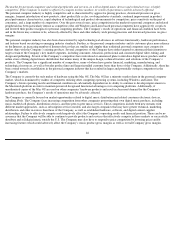Apple 2005 Annual Report Download - page 51
Download and view the complete annual report
Please find page 51 of the 2005 Apple annual report below. You can navigate through the pages in the report by either clicking on the pages listed below, or by using the keyword search tool below to find specific information within the annual report.
Failure to do so could result in lost revenue, loss of reputation, and significant warranty and other expense to remedy.
Because orders for components, and in some cases commitments to purchase components, must be placed in advance of customer orders, the
Company faces substantial inventory risk.
The Company records a write-down for inventories of components and products that have become obsolete or are in excess of anticipated
demand or net realizable value and accrues necessary reserves for cancellation fees of orders for inventories that have been cancelled. Although
the Company believes its inventory and related provisions are currently adequate, given the rapid and unpredictable pace of product
obsolescence in the computer and consumer electronics industries and the transition to Intel-based Macintosh computers, no assurance can be
given that the Company will not incur additional inventory and related charges. In addition, such charges have had, and may have, a material
effect on the Company’s financial position and results of operations.
The Company must order components for its products and build inventory in advance of product shipments. Because the Company’s markets
are volatile and subject to rapid technology and price changes, and because of the transition to Intel-based Macintosh computers, there is a risk
the Company will forecast incorrectly and produce or order from third parties excess or insufficient inventories of particular products.
Consistent with industry practice, components are normally acquired through a combination of purchase orders, supplier contracts, and open
orders based on projected demand information. Such purchase commitments typically cover the Company’s forecasted component and
manufacturing requirements for periods ranging from 30 to 150 days. The Company’
s operating results and financial condition have been in the
past and may in the future be materially adversely affected by the Company’s ability to manage its inventory levels and respond to short-term
shifts in customer demand patterns.
The Company is dependent on manufacturing and logistics services provided by third parties, many of whom are located outside of the U.S.
Most of the Company’s products are manufactured in whole or in part by third-party manufacturers. In addition, the Company has outsourced
much of its transportation and logistics management. While outsourcing arrangements may lower the cost of operations, they also reduce the
Company’s direct control over production and distribution. It is uncertain what effect such diminished control will have on the quality or
quantity of the products manufactured or services rendered, or the flexibility of the Company to respond to changing market conditions.
Moreover, although arrangements with such manufacturers may contain provisions for warranty expense reimbursement, the Company may
remain at least initially responsible to the consumer for warranty service in the event of product defects. Any unanticipated product defect or
warranty liability, whether pursuant to arrangements with contract manufacturers or otherwise, could adversely affect the Company’s future
operating results and financial condition.
Final assembly of products sold by the Company is currently performed in the Company’s manufacturing facility in Cork, Ireland, and by
external vendors in Fremont, California, Fullerton, California, Taiwan, Korea, the People’s Republic of China, and the Czech Republic.
Currently, manufacturing of many of the components used in the Company’s products is performed by third-party vendors in Taiwan, China,
Japan, Korea, and Singapore. Final assembly of substantially all of the Company’
s portable products including PowerBooks, iBooks, and iPods
is performed by third-party vendors in China. If for any reason manufacturing or logistics in any of these locations is disrupted by regional
economic, business, labor, environmental, public health, or political issues, as well as information technology system failures or military
actions, the Company’s results of operations and financial condition could be adversely affected.
49
























